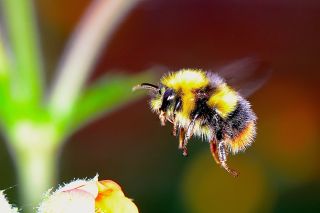Child Development
Why Do Children (and Animals) Play?
Here's what science says about why play might be important for our youngsters.
Posted May 8, 2023 Reviewed by Devon Frye
Key points
- Anyone who has owned a dog, cat, or even a bird knows that, like humans, animals play.
- Across various species, young animals are more likely than older ones to engage in play.
- Recently, scientists have even discovered play in the most unassuming of creatures: bumble bees.
- Although play doesn't seem to have immediate benefits, there might be several benefits in the long term.
The weather is getting warmer. Flowers are in bloom, the birds are singing, the bees are buzzing, and my allergies are killing me—spring is definitely in the air.
One of my favorite parts of the spring is coming home from work to the neighborhood kids playing outside and riding their bikes in the street. The pavement on my suburban sidewalk is chalky with drawings, and my neighbors’ “kids at play” sign is on the curb, warning passersby that they should drive a little bit more slowly this time of year.
And kids aren’t the only ones playing outside. Our birdfeeder is all of a sudden a virtual clubhouse for the local sparrows. Bunnies are frolicking on the front lawn, and deer can be seen chasing each other at sunrise.
Any of us who’ve owned a dog, cat, or even a bird knows that, like humans, animals play. My own 12-year-old dog who typically sleeps all day still pulls out her favorite toy for a brief romp a few times a week. My brother’s puppy plays constantly, to the point where we have to take her favorite ball away because she will literally drop dead of exhaustion before giving it up.
Scientists have known for decades that many animals engage in play. Recently, scientists have even discovered play in the most unassuming of creatures: bumble bees.

A new study that came out last year suggests that bumblebees will play with human toys when given the opportunity. In the study, researchers observed bumble bees as they traveled back and forth from their hive to a place where they could eat. But besides the ability to fly around and gather food, the bees were able to visit a separate area where there were several wooden balls.
The researchers’ question was simple: Do the bees stop to play with the balls, or do they ignore them and stick to hunting for food instead? The bees did indeed stop to play with the balls, rolling them around for no apparent reason, other than the possibility that it was fun.
These researchers and others who study animal behavior had four criteria for determining whether the bees’ behavior could be classified as “play.” First, the activity could not be related to any survival strategy and had to be intrinsically rewarding in some way; second, it had to look different from their usual food-related behaviors; third, it couldn’t be a one-off—it had to happen over and over again; and finally, it had to be initiated when the bees were not particularly stressed.
The bees’ behavior ticked all of these boxes. On top of that, there were differences based on the bees’ age and sex that matches play in other species—namely, play happened more often in younger bees, and more often in males than females (Dona et al., 2022).
Why does this happen? Why do the youngest members of various species engage in play? Psychologists don’t know for sure, and the issue is hotly debated. The only thing scientists can agree on is that play doesn’t have any immediate purpose—it happens purely because it is enjoyable. But given its commonality across a variety of species, scientists have wondered whether there is some broader purpose that play might serve.
Some psychologists, for example, think that play might help children learn some of the skills they need to be functioning adults. Playing might also help children master certain skills that build their own sense of efficacy or gives them an opportunity to learn new things (Pellegrini & Smith, 1998).
Further, there are different types of play that each might serve a different function. Rough and tumble play, or physical play, is the one most seen in other animals (and more often in males). It might give animals the opportunity to practice dominance hierarchies or gain physical strength. Object play—which is what the bees were doing when rolling the balls—might help individuals practice physical coordination and fine motor skills.
In humans, this type of play begins even in infancy. Fantasy play is uniquely human, and something that children don’t engage in until they reach the late toddler and early preschool years. It involves engaging in fantasy and pretending, and it could help children practice turn-taking and other important social skills.
Research has confirmed some of these theories. Playing outside is related to more physical activity; it can help fight against childhood obesity and cardiovascular disease (Tandon, Zhou, & Christakis, 2012), and help buffer against depression (Burdette & Whitaker, 2005). Further, playing outside is related to more focused and less fidgety behavior afterward (Burriss & Burriss, 2011).
Unfortunately, playtime is on the decline, especially outdoor play. Between the years 1981 and 1997, unstructured playtime dropped by about 25 percent (Hofferth & Sandberg, 2001), and a more recent survey of nearly 9,000 families with preschool-aged children in the United States indicated that about half do not go outside to play regularly (Tandon, Zhou, & Christakis, 2012).
One of the most famous child psychologists in history, Jean Piaget, once said, “Play is the work of childhood.” And not just human childhood—play seems to be an important part of childhood for young animals as well. Given its benefits, perhaps we should do as the bees do and encourage children to take some extra time out of their day to play.
So this spring, take a minute and encourage your kids to put down those tablets and play outside—the benefits might be worth buzzing about.
References
Burriss, K., & Burriss, L. (2011). Outdoor play and learning: Policy and practice. International Journal of Education Policy and Leadership, 6(8), 1-12.
Dona, H. S. G., Solvi, C., Kowalewska, A., Mäkelä, K., MaBouDi, H., & Chittka, L. (2022). Do bumble bees play? Animal Behaviour, 194, 239-251.
Hofferth, S. L., & Sandberg, J. F. (2001). Changes in American children's time, 1981–1997. Advances in life course research, 6, 193-229.
Pellegrini, A. D., & Smith, P. K. (1998). The development of play during childhood: Forms and possible functions. Child Psychology and Psychiatry Review, 3(2), 51-57.
Tandon, P. S., Zhou, C., & Christakis, D. A. (2012). Frequency of parent-supervised outdoor play of US preschool-aged children. Archives of pediatrics & adolescent medicine, 166(8), 707-712.




